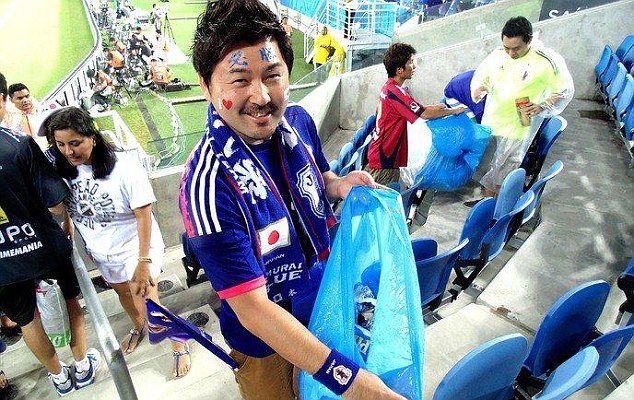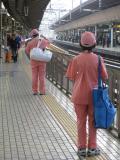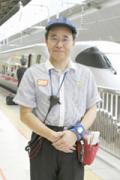Are Japanese train-cleaners faster than a speeding bullet?
Article ECJ
14th of July 2014

Possibly the world's fastest cleaners are the team responsible for cleaning the Japanese bullet train between each journey.
The team is said to be able to clean an entire train in seven minutes flat.
The Japanese bullet train -- or shinkansen as it is known over there - is capable of speeds up to 200kph and more than 300 trains are in service every day.
The average stop time is just 12 minutes and since it takes five minutes for passengers to alight and board, only seven minutes are left for the cleaning operation to take place.
As the train arrives at the Tokyo platform, cleaners armed with rubbish bags line up by the doors and bow as it pulls in. Holding open their bags, the cleaners thank the alighting passengers for handing over their discarded newspapers, drink cans and wrappers.
Staff then run through the train picking up further rubbish, replacing dirty seat covers, wiping down tray tables, sweeping floors and checking the over-seat luggage racks for rubbish.
When the operation - which has become known as the "seven-minute Shinkansen theatre" - is complete, the cleaners line up by the train again and perform a second bow before departing for their next job.
The cleanliness of Japanese people was recently highlighted globally during the 2014 FIFA World Cup in Brazil. After witnessing their team lose their opening match, Japanese spectators astounded onlookers by cleaning up the rubbish on their side of the stadium.
Source: ihcsacafe-en.ihcsa.or.jp/news/tessei/
Race against the clock: Shinkansen staff have just 7 minutes to get bullet train ready to ride
Cara CleggCara Clegg Apr 27, 2014

Japan’s shinkansen, or bullet train in the West, was the world’s first high-speed train running at 200km per hour, and today the Tōkaidō Shinkansen is the world’s most used high-speed rail line. Impressively, even with over 120,000 trains running on the line each year, the average delay time is a mere 36 seconds!
Part of the reason the bullet train system can run as smoothly as it does is thanks to the ‘hospitality group’ working behind the scenes of the sleek, futuristic facades of these famous trains. These cleaning crews are charged with covering every inch of a train’s interior when it arrives at its final stop and preparing it for the next wave of customers–and they have just seven minutes to do it.
What is TESSEI?
JR East’s rail service company is known as TESSEI, and it is responsible for the cleaning of the bullet trains when they have come to a stop at Tokyo Station. There are around 820 staff members including full-time staff and part-timers known as ‘partners’. The average employee age is 52, and around 50 percent of them are women, so people often talk affectionately of the TESSEI ‘obaa-sans’ or ‘grannies’.
Bullet trains shuttle in and out of the platforms at Tokyo station 210 times each day. TESSEI staff are divided into teams composed of 22 people, and with 11 teams of cleaners taking turns on the platform, which translates into each TESSEI employee cleaning around 20 trains per day.
Despite not being particularly glamorous work, the group has received a lot of media attention over the years, and have been called Japan’s ‘strongest team’ by the Nikkei Business magazine.
So what exactly does the job entail?
 Image: Chakotay
Image: Chakotay
Speed cleaning
Trains spend only 12 minutes at the station in Tokyo. That includes two minutes for passengers to disembark and two more for the next to get on, leaving only seven minutes for cleaning.
One person is in charge of one car with around 100 seats, and the whole car must be made spotlessly clean during those crucial seven minutes. It’s the same for the toilet cleaning staff – no matter how dirty it is, they have to have it sparkling again within the time limit. And lest we forget, the shinkansen aren’t like inner-city trains — passengers often travel for hours at a time, getting settled for the long ride, eating meals, snacking, reading newspapers, and generally making a bit of a mess.
The strict seven-minute deadline means that the work is broken down into smaller blocks that have to be completed in record time: 1.5 minutes spent picking up trash, 30 seconds rotating the seats (some can be swivelled around so that larger groups can face one another), four minutes sweeping and cleaning, and a one-minute check.
 Image: Attiecannie
Image: Attiecannie
Those crucial seven minutes
0:00~1:30 First check the luggage racks on both sides, then look down the gaps between the seats for any forgotten items. As the seats are being turned to face the direction of travel, run down to the door at the other end sweeping out dropped trash into the aisle along the way.
1:30~4:30 On the way back up the aisle, pull down and check the blinds, and at the same time pull out the seat-back trays and wipe everything down, and change the seat covers if they’re dirty.
4:30~6:30 There’s now only two minutes left. Take a broom and sweep up all the trash brought out into the aisle in one go.
Everything above is expected to be completed in about six minutes. The official time limit is seven minutes, but it’s often crowded and takes longer for passengers to disembark, so they rarely have the luxury of using the full seven. This almost superhuman feat is known in Japanese as the ’7-minute shinkansen theatre’
Why does it work?
TESSEI was reformed into the company it is today nine years ago. At the time the workers were treated as mere dispatch cleaners, and had low morale and dedication to their job. This led to the cleanliness of the shinkansen suffering and not living up to the expectations held by its millions of passengers.
One of the main changes involved in the overhaul was redefining the work as ‘service’ rather than ‘cleaning’, and endeavoring to create a sense of pride in the job. Another major factor is the importance of teamwork, with input coming not just from the supervisors but from everyone in the team. Every day they will hold a team meeting to thoroughly discuss any issues no matter how trivial, and every member gets a say. Furthermore, the teams are not fixed, and will be shuffled around so that everyone gets a chance to work with and learn from lots of different people.
From 2007 the Angel Report has been the most effective method of raising morale amongst the team members. This is a public report that’s sent out internally and pasted to the office walls where staff who have worked exceptionally hard are given a public shout-out and thanks.
 Image: IHCSA Cafe
Image: IHCSA Cafe
Omotenashi: Japanese hospitality
You might have heard the Japanese word ‘omotenashi’ in conjunction with the 2020 Olympic bid. It basically represents the concept of Japanese hospitality, and the country is very keen to continue to promote the image of politeness that many foreigners have of it.
TESSEI has its own brand of omotenashi that you can witness whenever you’re waiting to board the train, as the TESSEI staff line up to start their speed clean. One of the fascinating things for passengers, particularly foreigners, to observe is the way all the staff will bow to the train on its arrival and departure from the station, and to the passengers before they board.
 Image: Toku58
Image: Toku58
Other unique ideas to jazz up their job and put smiles on people’s faces have come from the staff themselves, such as having seasonal flowers on their hats, or wearing bright Hawaiian shirts in summer.
Celebrity endorsement (sort of)
TESSEI’s incredible service has garnered admiration and praise around the world. Upon visiting TESSEI, the French national rail president commented that he wanted to import the idea to France. And last month a group of professors from Harvard University visited TESSEI and discussed including the company in teaching materials at the graduate school of business.
But probably the best endorsement the group received was from former Governor of California and all-round badass Arnold Schwarzenegger, who expressly went to observe the group when he visited Japan with the American transport chief. If it’s good enough for the Terminator, then it’s probably good enough for the rest of us!
Source: Naver Matome
Header Image: Richard Young @ PBase.com
On Board the Shinkansen

On October 1, 1964, the Tokaido Shinkansen began running between Tokyo and Osaka as Japan’s first high-speed railway. Today, it continues to operate at speeds of up to 270km an hour, and after nearly half a century has yet to see any major accidents. The cars barely shake, offering a smooth, comfortable ride, and the first train of the day is spotless, with everything in perfect order. They invariably run on time. The Shinkansen is truly the culmination of Japanese quality.

Cleaning staff await the arrival of the “Nozomi” Shinkansen at Tokyo Station’s Platform 16. Their work takes place in the limited time between the train’s arrival and its next departure . The staff of Shinkansen Maintenance Tokai Co., Ltd. are the ones responsible for providing a comfortable on-board experience and helping to ensure on-time operations.
Cleaning staff in matching pink uniforms line up on the platform to await the next Shinkansen’s arrival.

Noriko Abe is responsible for supervising all train car cleaning. Since cleaning can also affect operating schedules, she needs to be on her toes every day.

1.Each team starts with a team meeting. Announcements are made, any special precautions are gone over, and the team warms up with calisthenics.

2. Each squad then checks its equipment.

3. A broom developed to notify workers of any dampness on seats in the train cars (Official name: Seat Whisk Broom-Equipped Dampness Detector). Airlines and other companies have expressed an interest.

4. Once cleaning is completed, each team member confirms that her area is done.

Each disembarking passenger is given a proper greeting. Once the last passenger is off, the cleaning starts. Still, the cleaning staff will sometimes stop to help passengers with unwieldy baggage.

Seats are returned to their original positions and flipped to face the direction of travel. On the Tokaido Shinkansen, this is done using a footoperated pedal. Skill is required to operate the pedal and flip the seat around at the same time.

As they remove the seat back covers, workers are also on the lookout for refuse and dirt along windowsills and on the seats.

Toilets are thoroughly scrubbed. Depending on the situation, this can take time or be finished quickly.

Emptying ashtrays in the smoking room. Workers must check for any stillburning butts.

Each seat back cover is put neatly in place and smoothed to remove any wrinkles. Even as the workers rush, their movements are precise.

Seat back covers are distributed along each row. The workers quickly and accurately lay out the correct number of covers.

Trash is separated and collected. When volume is heavy, as with trains used by school groups, more staff are added to collect the trash.

Seats are swept with a whisk broom. The brooms are equipped with sensors, enabling workers to detect any damp spots. Unusable seats are switched out.

Broom in the right hand, cleaning cloth in the left. Skilled workers learn to sweep and wipe at the same time, conferring on them the title of “masters of the two-sword technique.”

Floors are swept to remove any trace of dust. Around this time, the train’s loudspeaker will announce “Two minutes to go,” and the teams prepare to pull out.

Even the finest cigarette ashes are carefully and completely wiped away. Floors are left spotless, too.

A mirror is used to check for any items left behind on the luggage racks. Jumping up to check the racks can lead to back injuries, so a hand-mirror is essential.

With one eye on the clock, workers still find time to do a last, thorough check of their work. They make sure they have all of their tools with them before removing the “Cleaning in Progress” sign and leaving the train.

Ms. Abe waits for the signal from each car that cleaning is done. After confirming that all the cars have been completed, she contacts JR. Another job well done!
- Войдите или зарегистрируйтесь, чтобы получить возможность отправлять комментарии
-















